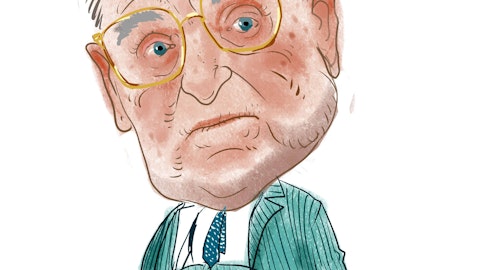Columbia Banking System, Inc. (NASDAQ:COLB) Q2 2023 Earnings Call Transcript July 19, 2023
Columbia Banking System, Inc. misses on earnings expectations. Reported EPS is $0.81 EPS, expectations were $0.93.
Operator: Hello and thank you for standing by. Welcome to Columbia Banking System’s Second Quarter 2023 Earnings Conference Call. [Operator Instructions] At this time, I would like to introduce Jacque Bohlen, Investor Relations Director for Columbia to begin the conference.
Jacque Bohlen: Thank you, Towanda. Good afternoon, everyone. Thank you for joining us as we review our second quarter 2023 results, which we released shortly after the market closed today. The earnings release and corresponding presentation, which we will refer to during our remarks this afternoon, are available on our website at columbiabankingsystem.com. With me this afternoon are Clint Stein, President and CEO of Columbia Banking System; Chris Merrywell and Tory Nixon, the Presidents of Umpqua Bank; Ron Farnsworth, Chief Financial Officer; and Frank Namdar, Chief Credit Officer. After our prepared remarks, we’ll take your questions. During today’s call, we will make forward-looking statements, which are subject to risks and uncertainties and are intended to be covered by the Safe Harbor provisions of federal securities law.
For a list of factors that may cause actual results to differ materially from expectations, please refer to Slide 2 of our earnings presentation as well as the disclosures contained within our SEC filings. We will also reference non-GAAP financial measures alongside our discussion of GAAP results. We encourage you to review the GAAP to non-GAAP reconciliations provided in our earnings release and throughout the earnings presentation. I will now turn the call over to Clint.
Clint Stein: Thank you, Jacque. Good afternoon, everyone. It was another productive quarter for Columbia. Merger integration activity remains a heightened priority, but we are nearing its completion as milestones continue to be achieved on or ahead of schedule. I am pleased to report we have already surpassed $100 million in cost synergies. We remain on track to meet our original target over the next 2 months and additional opportunities beyond $135 million have already been identified. We’re 4 months out from the systems conversion that took place in March, and our teams are benefiting from unified systems, products and services. We have the necessary tools and support to win new business and expand existing relationships as we use our scale to drive revenue synergies across both legacy customer bases.
Our enhanced footprint provides new opportunities to deploy successful businesses into new markets, which supports our strategy to drive balanced growth. However, the current environment is not without its challenges. Our balance sheet is not immune to quantitative actions affecting industry deposit balances and contributing to the modest remix of our deposit base. Our talented associates, service-driven operating model and expansion in newer markets provide us with opportunities and resources to retain our favorable placement within the industry. As I look at our footprint throughout 8 Western states, I’m excited by our prospects to grow our business in each of these markets. I will now turn the call over to Ron.
Ron Farnsworth: Okay. Thank you, Clint. And for those on the call who want to follow along, I will be referring to certain page numbers from the earnings presentation. Starting on Slide 4, we are projecting achievement of $105 million in cost synergies as of June 30. Again, we are well on track to hit the $135 million in annualized target as of September 30 and are targeting a higher number by year-end as we complete the final stages of integration. Next, on Slide 5. We present the remaining balance of discount marks as compared to the prior quarter and at closing. For the AFS portfolio, the acquired discount was reduced $20 million via accretion to interest income. In our earnings release detail, we include this $20 million along with $17 million of higher bond interest income from the portfolio restructure, we completed post close to arrive at the $37 million of total accretion for bonds.

Iakov Filimonov/Shutterstock.com
On the loan side, we had $30.5 million of rate accretion and $7.1 million for credit. The total marks declined $75 million in Q2 through a combination of accretion interest income and the loan sale. Slide 6 covers our liquidity, including deposit flows during the quarter. For comparability, we presented the table on the left as if we were combined for all periods presented. Total deposits declined 1.8% in the second quarter. Market liquidity tightening and the impact of inflation on consumer spending continued to pressure customer deposit balances. We utilize short-term broker deposits and Federal Home Loan Bank borrowings to fund the outflows and maintain the higher on balance sheet liquidity. The upper right table details our off-balance sheet liquidity with $10.3 billion available as of quarter ahead.
Below that, we had cash and excess bond collateral not pledged for loans to arrive a total available liquidity of $18.1 billion. This represents 134% of uninsured deposits as of quarter end. On the next page, Slide 7, we detailed out the investment portfolio. The upper left table takes you from current par to amortize costs to fair value, knowing the difference between current par and amortized cost is the combined net discount, which will be accretive to interest income over time. The decline in market value this quarter, of course, resulted from slightly higher market yields on the front end of the curve. As you can tell, I’m excited about this portfolio as it does give us significantly higher and stable earnings stream with greater optionality.
The overall book yield was 3.58% with an effective duration of 5.7 as of quarter end. And lastly, we only have $2.4 million in HTM bonds, which represents some CRA-related bonds with no unrealized loss. To better help investors given the combination accounting and moving parts on Slide 8, we provided an updated outlook for 2023 on several key financial statement items. Our lower NIM assumptions incorporate the second quarter’s funding remix, guided ranges incorporate stability at the upper end of the range and continued remix at the lower end. Our GAAP NIM is further impacted by lower accretion estimates as higher interest rates have slowed prepayment assumptions, delaying the realization of the discount into income. On our expense outlook includes an estimate for the FDIC special assessment we expect to hit in Q3, and we continue to expect the quarterly expense run rate ex CDI in the $240 million to $250 million range in Q4.
This run rate includes the realization of all cost savings by September 30 and is unchanged from last quarter’s guide. Slides 10 through 12 provide summary financials for Q2, but I want to take you forward to Slide 13. Here, we break out Q2 GAAP earnings to help investors understand the non-operating and merger-related impacts and resulting core bank results in the faraway column. The first column represents our Q2 GAAP fully combined results, with the net income of $133 million or $0.64 per diluted share. The second column includes our non-operating designation for income statement changes mostly related to fair value swings along with $29.6 million of merger costs included in non-interest expense, which are detailed as in the appendix. These net to a $36 million reduction in Q2 earnings, resulting in the third column for operating income.
Our operating income for Q3 on a fully combined basis was $169.4 million or $0.81 per diluted share with our return on assets at 1.3% and return on tangible common equity at 21.1%. The fourth column presents the net effect of the merger accounting, which net to $29 million or $0.14 per diluted share. Taking us to the last column, which showed the core bank, excluding the merger accounting benefit with solid results of $440 million in income or $0.67 per diluted share and 17.5% return on tangible equity. While this is lower than expected when our combination was announced, it reflects higher borrowing costs with Q2 deposit outflows. Even with the higher interest expense, it is great to see the benefit of this combination with a 17.5% return on tangible equity, excluding a net merger accounting benefit.
Now I’m going to reiterate this Page 13 is the key page. The bridge from GAAP reported earnings, isolated non-operating and fair value changes, then the merger-related items of discount accretion and CDI and then to adjusted operating income. The discount accretion will be a steady and reliable source of interest income over time as the majority is driven by rate, not credit, providing with a steady build of capital over time as well. We continue to clearly highlight it here to aid investors in valuing both the accretion and the core bank appropriately. Okay. With that, moving ahead for a couple of more items. Slide 15 breaks out accretion from net interest income. Slide 16 does the same for the margin. The decline in NIM from the prior quarter and from prior expectations resulted directly from higher borrowing costs to offset the QT field deposit declined.
The NIM, excluding PAA for the month of June was 3.26%, slightly under the Q2 level of 3.32%. And the excess liquidity held on balance sheet had a roughly 17 basis point impact on the month of June NIM. Slide 17 breaks out the repricing and maturity characteristics of the loan portfolio, noting 42% is fixed, 28% is floating and 30% are adjustable. And Slide 18 provides an updated view of our combined interest rate sensitivity under both ramp and shock scenarios. We have taken proactive measures to reduce the balance sheet sensitivity to a future declining rate environment. As you can see here, the trending over the past few quarters where our rates break down where our rates down risks have been reduced significantly. In noted below, we calculate our cycle-to-date funding betas, which are calculated on a combined company basis over the periods presented for comparability.
As of the second quarter, our interest-bearing deposit portfolio is priced in 31% of the Fed funds rate increases. Notable here is the cost of interest-bearing deposits, which at 1.83% for the month of June matches the quarter end spot rate of 1.3% highlighting stability. And finally, in the back on Slide 28, we highlight our regulatory capital position, noting our risk-based capital ratios increased roughly 20 basis points in Q2. We expect to quickly approach our long-term capital targets of 12% on total risk-based capital, which will provide for enhanced flexibility to return excess capital to shareholders. And with that, I will now turn the call over to Frank.
Frank Namdar: Thank you, Ron. Turning to Slide 21, origination volume of $1.2 billion in the quarter was offset by prepayments, payoffs and the decision to sell roughly $500 million in non-relationship loans as outlined in our earnings release. Excluding sales and reclassifications to held for sale, loans expanded by 5% on an annualized basis during the quarter. Slide 22 details select characteristics of our loan portfolio by a major category with added detail surrounding production during the second quarter. Additional industry detail for our commercial portfolio is provided on Slide 23 and Slide 24 provides a number of data points on our office portfolio, given investor focus on this asset category. I encourage you to review it in detail as it provides credit and repricing information on this diversified, granular portfolio that is primarily supported by properties located in suburban markets.
Moving on. Slide 25 highlights our reserve coverage by loan category. Additionally, the remaining credit discount on loans provides a further 25 basis points of loss-absorbing capacity. The $16 million provision expense recorded during the quarter reflects several variables, which include stabilizing credit trends in the FinPac portfolio and reserve release associated with non-relationship commercial loans that were sold and reclassified. Slide 26 provides an overview of our consolidated credit trends. In general, our credit performance is and has remained positive ex the anticipated trend in FinPac charge-offs. As previously communicated FinPac charge-offs remained elevated during the second quarter, still centered in the trucking sector of the portfolio.
Early-stage delinquency trends continue to improve indicative that a plateau has been reached. Charge-offs will retreat at a lag. There is no indication of any spillover to the broader commercial portfolio or other sectors within FinPac. Excluding FinPac, charge-off activity at the bank remains at a very low level. I’ll now turn the call over to Tory.
Tory Nixon: Thank you, Frank. Turning to deposits. Slide 27 highlights the quality of our granular deposit base. Market liquidity tightening, the impact of inflation on consumer spending and businesses use of cash contributed to the modest deposit contraction and remix that took place during the second quarter. Due to the ongoing efforts and expertise of our bankers, we continue to have a very high rate of customer retention. We successfully consolidated 47 branches over a 4-week period in May and June, an extensive planning process, proximity of existing Umpqua Bank branches to locations that were closed, and the outstanding customer service provided by our teams contributed to our ability to execute consolidations without disrupting our customers or impacting accounts in any discernible way.
As Clint highlighted, we are taking strategic actions to further support our focus on relationship banking. The sale of non-relationship loans aligned with our intent to deploy liquidity into business-generating activities that provide more balanced growth opportunities, continued expansion of products and services, like deposit gathering capabilities to support our commercial banking teams and wealth management options within existing and newer markets provides avenues for growth and enhanced company profitability. We continue to add talent across our footprint and our team’s success drives our enthusiasm for future prospects. I will now turn the call back over to Clint.
Clint Stein: Thanks, Tory. Our regulatory capital position is outlined on Slide 28. We remain above both well-capitalized and internal threshold targets. We increased our regular dividend during the second quarter to $0.36 per share, highlighting the foundational strength of our combined organization. And as Ron discussed, we expect capital to continue to accrete quickly in the coming quarters providing us with ample flexibility for future shareholder return. This concludes our prepared comments. The team is now available to answer your questions. Towanda, please open the call for Q&A.
See also 30 Cities with the Highest Altitudes in the World and 20 Most Efficient Countries in the World.
Q&A Session
Follow Second Sainter Co (NASDAQ:COLB)
Follow Second Sainter Co (NASDAQ:COLB)
Operator: [Operator Instructions] Our first question comes from the line of Jeff Rulis with D.A. Davidson. Your line is open.
Jeff Rulis: Thanks and good afternoon. Clint, maybe I could just tackle that last comment that you had on capital. It looks like your CET1 target now north of 9% or north of the target, I should say. I guess just fully fleshing that on, I mean, you raised the dividend, but kind of want to see or check in on the attractiveness of the buyback or further from here potentially on the dividend, either an increase or special from here?
Clint Stein: Sure. So if you think about the various ratios, the one that is the – I guess, the constraint at the current time is total risk-based capital. Our long-term target for that and it has been for quite a while is 12%. And so we still got a little bit of room to grow into that target and just in general, if you take the regulatory requirements to be well capitalized at 150 basis points. So whatever ratio you are using, that’s going to align pretty closely with how we think about our optimum long-term targets. So we are not there on total risk-based capital yet. But when we do get there and as we have talked over the past couple of quarters and in our prepared remarks, capital will accrete pretty quickly. And all those things you mentioned will be things that we will discuss with our Board and certainly remain distinct possibilities in terms of regular dividend, special dividends and the potential for buybacks, but not in the next quarter or so, I don’t think.
Jeff Rulis: Okay, got it. And then checking in on the, I guess, expectations for deposits in the second half, both deposit flows I guess that’s the first question on balances. The second question would just be your betas either the total beta at 19% or interest-bearing at 31%. I think Ron mentioned maybe some indication of some stability there. I just wanted to check in on your terminal deposit beta expectations. So one part, deposit flows, second part is sort of the terminal beta? Thanks.
Ron Farnsworth: Hey, Jeff. Good afternoon. This is Ron. Let me take the last part of that and I’ll turn it back to Tory for the first part. So on the betas, yes we are at the 31% cumulative. Our model is closer to 50%, 53% per the footnotes on that page. But as we’ve said pretty consistently over the last couple of quarters, we expect to be below that by the time we get to the end of this raise in the cycle or at least a couple of quarter lag on the back end of that. So I’d expect continued modest increase in that beta, but staying a little shy of the 50%. Tory?
Tory Nixon: Yes. I mean if you look at the kind of the flow deposits, we did a lot of analysis over the course of the quarter. I mean I kind of go back to Slide 27, if you look at the granularity of the deposit base, I mean our average consumer deposit is $19,000. Our average commercial deposit is $107,000. And most of the analysis really just shows the flow of cash is normal business usage and some quantitative tightening inflation up, but just kind of normal business activity and normal business usage. So pipelines for us on deposits look really, really strong and as we went through conversion and the teams were out – they have kind of turned their attention outbound and really working hard to generate a lot of activity. So I feel really good about the energy and the activities that are happening in the company on – certainly on the fee income and on the deposit side.




